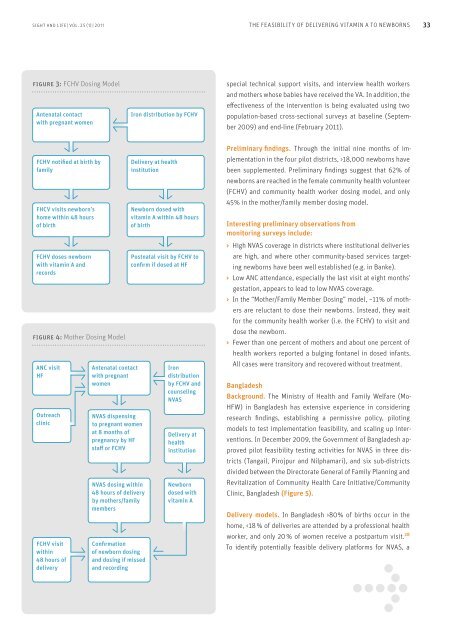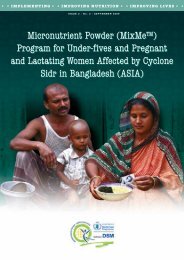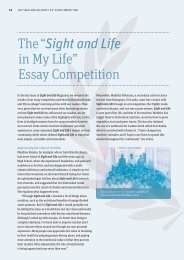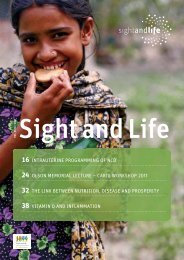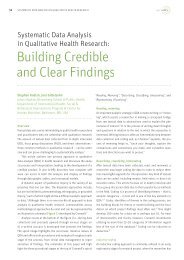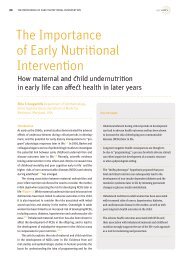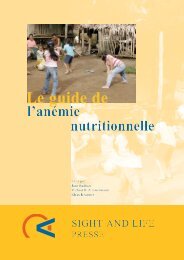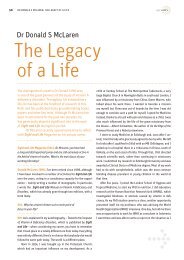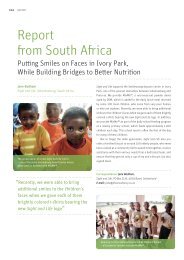32 THE FEASIBILITY OF DELIVERING VITAMIN A TO NEWBORNSFigure 2: Map of NVAS pilot districts in NepalNVAS pilot districtsFar-WesternRegionBankeIndiaMid-WesternRegion0 20 60 100 KilometersWestern RegionNawalparasiTanahuCentral RegionFCHV dosing modelMother dosing modelSindhuliEastern Regionrecommendation: “Operational research on how to reach mostbabies in developing countries within two days of birth shouldbe conducted in general, not necessarily in the context of neonatalvitamin A supplementation.” The consultation also revieweda systematic review of neonatal vitamin A trials. 25 It concludedthat insufficient evidence existed to recommend a global policyof supplementing newborns with vitamin A until further efficacytrials in appropriate populations are conducted in Africa <strong>and</strong>Asia. WHO is currently supporting additional efficacy studies inAfrica (Tanzania <strong>and</strong> Ghana) <strong>and</strong> South Asia (India), as well asstudies investigating potential biological mechanisms throughwhich NVAS may decrease the risk of early infant mortality.Program implicationsAdequate <strong>and</strong> effective NVAS will require innovative but feasibleprograms in South Asian settings, where often >80% of infantsare born at home. For example, newborn dosing might requireidentifying <strong>and</strong> engaging neighborhood “watch” networks todetect births <strong>and</strong> rapidly dose infants, or using cell phones tocontact health workers at the time of birth. The capsule wouldneed to be widely available, perhaps through both the private<strong>and</strong> public sectors. It could be included as a new component in“safe birthing kits” for women to use themselves (obtained duringantenatal care or purchased in local shops), provided at thetime of home-delivery by nurse midwives or trained traditionalbirth attendants or, lastly, at clinic- or hospital-based obstetriccare <strong>and</strong> delivery programs. Newborn VA delivery could be combinedwith other emerging <strong>and</strong> effective neonatal care services,such as cord cleaning with chlorahexadine wipes 26 <strong>and</strong> newborncare intervention packages. 27 It could provide an opportunityto establish birth dates <strong>and</strong> set the timing for an infant’s “sixmonth”VA-dosing visit – an idea that is currently gaining interest.Alternatively, in contexts where a high proportion of womenattend antenatal clinics, women could be given the supplement<strong>and</strong> instructed on its use <strong>and</strong> administration, <strong>and</strong> then give itdirectly to their newborn shortly after birth.NVAS feasibility activities purposeIn both Nepal <strong>and</strong> Bangladesh, NVAS feasibility activities wereto identify, develop, <strong>and</strong> evaluate feasible models for deliveringNVAS integrated within existing ante- <strong>and</strong> postnatal interventionsat a scalable level within existing delivery platforms <strong>and</strong>government health services.NepalBackground. Nepal is on track to meet its Millennium DevelopmentGoal (MDG)-4 to reduce under-five mortality by two-thirds;however, the government is finding ways to make further reductionsby seeking efficacious interventions that reduce neonatal<strong>and</strong> early infant deaths. The Child Health Division, Departmentof Health Services of the Nepal Ministry of Health <strong>and</strong> Populationformulated a policy to pilot first, <strong>and</strong> piloted NVAS in 2009in four districts (Figure 2), in partnership with the USAID-fundedNepal Family Health Program-II (NFHP-II), UNICEF, <strong>and</strong> theMicronutrient Initiative (MI).Delivery models. Considering that ~80% of births in Nepaloccur in the home, the extensive network of female communityhealth volunteers (FCHVs), <strong>and</strong> the government’s effortsto intensify <strong>and</strong> improve access to Antenatal Care services,Nepal selected two distribution models for feasibility testing:1. The “FCHV Dosing” model, using postnatal home visits byfemale community health volunteers to administer vitamin Adirectly to newborns in two districts (Banke <strong>and</strong> Nawalparasi)(Figure 3); <strong>and</strong>2. The “Mother / Family Member Dosing” model, in which motherswho attend an antenatal clinic at a health facility (HF), or arevisited at home by the FCHV after the eighth month of pregnancy,are counseled about NVAS <strong>and</strong> given a supplement which theygive directly to their newborn, also in two districts (Sindhuli <strong>and</strong>Tanahu) (Figure 4).Monitoring <strong>and</strong> evaluation. NVAS implementation is beingmonitored through the routine government health management<strong>and</strong> information system. To record information on NVASreceipt, the existing Iron Intensification Register, a record usedto track iron <strong>and</strong> folic acid tablet receipt among pregnant <strong>and</strong>postpartum mothers, was modified. Data from this record arecompiled <strong>and</strong> sent monthly to the district <strong>and</strong> national levels.In addition, three to four external monitors per district provide
SIGHT AND LIFE | VOL. 25 (1) | <strong>2011</strong> THE FEASIBILITY OF DELIVERING VITAMIN A TO NEWBORNS 3333figure 3: FCHV Dosing ModelAntenatal contactwith pregnant womenIron distribution by FCHVspecial technical support visits, <strong>and</strong> interview health workers<strong>and</strong> mothers whose babies have received the VA. In addition, theeffectiveness of the intervention is being evaluated using twopopulation-based cross-sectional surveys at baseline (September2009) <strong>and</strong> end-line (February <strong>2011</strong>).FCHV notified at birth byfamilyFHCV visits newborn’shome within 48 hoursof birthFCHV doses newbornwith vitamin A <strong>and</strong>recordsfigure 4: Mother Dosing ModelANC visitHFOutreachclinicFCHV visitwithin48 hours ofdeliveryAntenatal contactwith pregnantwomenNVAS dispensingto pregnant womenat 8 months ofpregnancy by HFstaff or FCHVNVAS dosing within48 hours of deliveryby mothers/familymembersConfirmationof newborn dosing<strong>and</strong> dosing if missed<strong>and</strong> recordingDelivery at healthinstitutionNewborn dosed withvitamin A within 48 hoursof birthPostnatal visit by FCHV toconfirm if dosed at HFIrondistributionby FCHV <strong>and</strong>counselingNVASDelivery athealthinstitutionNewborndosed withvitamin APreliminary findings. Through the initial nine months of implementationin the four pilot districts, >18,000 newborns havebeen supplemented. Preliminary findings suggest that 62% ofnewborns are reached in the female community health volunteer(FCHV) <strong>and</strong> community health worker dosing model, <strong>and</strong> only45% in the mother/family member dosing model.Interesting preliminary observations frommonitoring surveys include:> High NVAS coverage in districts where institutional deliveriesare high, <strong>and</strong> where other community-based services targetingnewborns have been well established (e.g. in Banke).> Low ANC attendance, especially the last visit at eight months’gestation, appears to lead to low NVAS coverage.> In the “Mother/Family Member Dosing” model, ~11% of mothersare reluctant to dose their newborns. Instead, they waitfor the community health worker (i.e. the FCHV) to visit <strong>and</strong>dose the newborn.> Fewer than one percent of mothers <strong>and</strong> about one percent ofhealth workers reported a bulging fontanel in dosed infants.All cases were transitory <strong>and</strong> recovered without treatment.BangladeshBackground. The Ministry of Health <strong>and</strong> Family Welfare (Mo-HFW) in Bangladesh has extensive experience in consideringresearch findings, establishing a permissive policy, pilotingmodels to test implementation feasibility, <strong>and</strong> scaling up interventions.In December 2009, the Government of Bangladesh approvedpilot feasibility testing activities for NVAS in three districts(Tangail, Pirojpur <strong>and</strong> Nilphamari), <strong>and</strong> six sub-districtsdivided between the Directorate General of Family Planning <strong>and</strong>Revitalization of Community Health Care Initiative/CommunityClinic, Bangladesh (Figure 5).Delivery models. In Bangladesh >80% of births occur in thehome,


